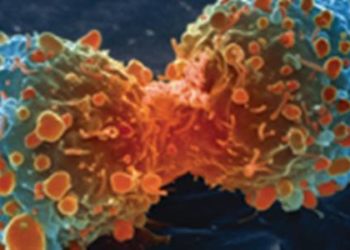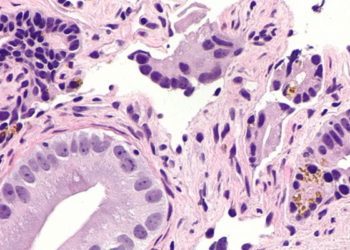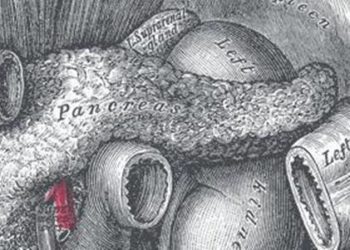Olanzapine as an adjunct to standard antiemtic therapy for patients receiving chemotherapy
1. The addition of olanzapine to standard antiemetic therapy had a significantly higher rate of complete response (defined as no vomiting and no use of rescue medication) in the delayed phase (24-120 hours after cisplatin-based chemotherapy initiation) compared to the placebo.
2. This significantly higher rate of complete response was maintained regardless of the presence or absence of risk factors such as histories of alcohol use, motion sickness, and morning sickness.
Evidence Rating Level: 1 (Excellent)
Study Rundown: Cisplatin-based chemotherapy is categorized as highly emetogenic chemotherapy (HEC). Standard antiemetic treatment consists of a triplet combination of 5-hydroxytryptamine type 3 receptor antagonist, neurokinin-1 receptor antagonist, and dexamethasone. The randomized control trial by Navari et al, and the J-FORCE trial demonstrated that the addition of olanzapine, an atypical antipsychotic drug, was effective against chemotherapy-induced nausea and vomiting (CINV). Therefore, the updated antiemetic guideline of the American Society of Clinical Oncology now includes the combination of olanzapine (at a dosage of 5 to 10 mg) with triplet therapy as standard antiemetic therapy for highly emetogenic chemotherapy. However, given that the contribution of risk factors was not analyzed, this preplanned secondary analysis of the J-FORCE trial aims to examine the add-on effect of olanzapine according to CINV risk factors.
The J-FORCE trial was a randomized, double-blind, placebo-controlled, phase 3 study conducted in Japan from February 9, 2017, to July 13, 2018. Recruited patients were randomly assigned to receive either olanzapine or the placebo in addition to triplet antiemetic therapy. The primary endpoint of delayed complete response (no vomiting and no use of rescue medication within 24-120 hours after cisplatin-based chemotherapy) was significantly higher for the olanzapine group than for the placebo group for the following subgroups: male, female, age 55 years or older, age younger than 55 years, receiving a cisplatin dose of 70 mg/m2 or more, cisplatin dose of 70 mg/m2 or more, with and without a drinking habit, without a history of motion sickness, and with a history of morning sickness during pregnancy. These findings suggest that treatment with olanzapine plus triplet antiemetic therapy at the initiation of chemotherapy is beneficial in managing CINV irrespective of the presence or absence of risk factors.
Click to read the study on JAMA Network Open
In-Depth [randomized control trial]: Patients scheduled for cisplatin-based chemotherapy between the age of 20 and 75 years were recruited from 26 hospitals in Japan and randomly assigned (1:1) to receive oral olanzapine 5mg or placebo along with the standard antiemetic therapy. The main outcome measure assessed in the study was the attainment of complete response (CR) in the delayed phase — the absence of vomiting and no use of rescue medications within 24-120h of chemotherapy initiation. The risk difference (RD) between the treatment and placebo group was analyzed according to CINV risk factors — sex, age, cisplatin dose, history of motion sickness, drinking habit, and history of morning sickness during pregnancy. 705 patients (mean [SD] age, 63.0 [9.2] years; 234 females [33.2%] and 471 males [66.8%]) of the total 710 patients enrolled in the J-FORCE trial were included. Patient characteristics between the olanzapine and placebo groups did not significantly differ. Delayed CR was significantly higher for the olanzapine group than for the placebo group in males (RD, 12.6% [95% CI, 5.0%-20.1%]; P = .001) and females (RD, 14.5% [95% CI, 2.2%-26.3%]; P = .02); those 55 years or older (RD, 11.1% [95% CI, 3.9%-18.2%]; P = .003) or younger than 55 years (RD, 23.6% [95% CI, 7.3%-38.3%]; P = .005); for a cisplatin dose of 70 mg/m2 or more (RD, 13.5% [95% CI, 5.9%-21.0%]; P < .001); those without a history of motion sickness (RD, 13.9% [95% CI, 6.9%-20.6%]; P < .001); with a drinking habit (RD, 14.9% [95% CI, 6.1%-23.4%]; P = .001) or without a drinking habit (RD, 12.0% [95% CI, 2.5%-21.3%]; P = .01). There was no significant difference between RD of opposing subgroups (e.g. male versus female, older than 55 years or younger than 55 years, etc.). Overall, these findings demonstrate that olanzapine is efficacious in countering CINV regardless of the presence or absence of risk factors, therefore it should be introduced from the time of initial chemotherapy.
Image: PD
©2023 2 Minute Medicine, Inc. All rights reserved. No works may be reproduced without expressed written consent from 2 Minute Medicine, Inc. Inquire about licensing here. No article should be construed as medical advice and is not intended as such by the authors or by 2 Minute Medicine, Inc.







